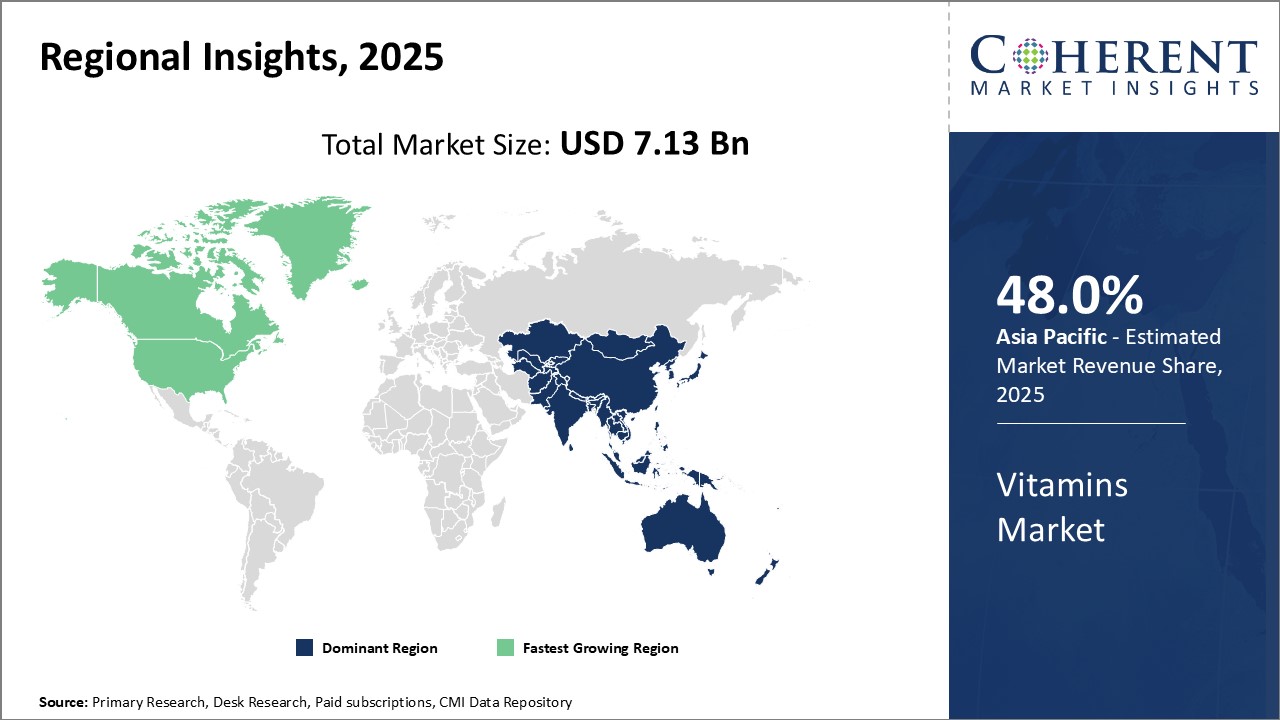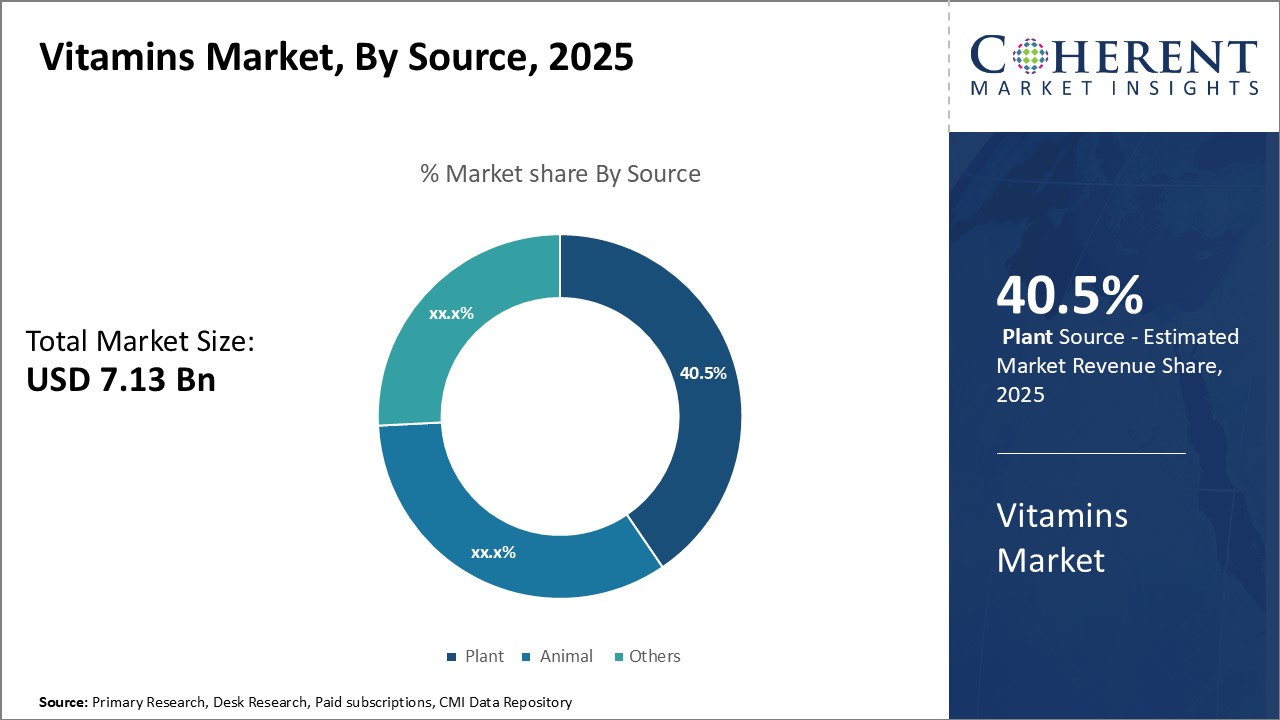The Vitamins Market size is valued at US$ 7.13 Bn in 2025 and is expected to reach US$ 11.01 Bn by 2032, growing at a compound annual growth rate (CAGR) of 6.4% from 2025 to 2032.
Market Regional Insights:
Figure 1. Vitamins Market Share (%), By Region, 2025

To learn more about this report, Request sample copy
Analyst’s Views:
The global vitamins market has strong growth potential over the next five years. The increasing health consciousness among consumers, along with rising disposable incomes in developing countries, will drive greater demand for dietary supplements containing vitamins. With growing awareness about deficiency diseases, preventative healthcare through regular vitamin consumption is becoming increasingly popular. The food and beverage industry is also expected to boost the market as manufacturers focus on fortifying products with essential vitamins. North America will continue holding a significant share owing to frequent new product launches and marketing initiatives by key players targeting older demographics. In Europe, favorable regulations in countries like Germany and the U.K. recognizing vitamins as essential components for disease prevention are conducive to business expansion. However, the easy availability of cheap alternatives from local manufacturers and cost pressures at various levels of supply chain could pose challenges. Also, over-encapsulation of vitamins in some supplements can adversely impact gut health of regular users if not consumed responsibly. This may require stricter quality control norms to ensure products provide only recommended dosages.
Market Drivers:
Growing health awareness and preventive healthcare: Increased focus on personal health and wellness has been a major societal trend over the past decade. With growing concerns around chronic diseases, pollution, stressful lifestyles, and aging populations, people are increasingly proactive about maintaining optimal nutrition levels through supplementation. This shift towards preventative healthcare approaches seeks to identify and address micronutrient deficiencies early in order to stave off future health issues. As consumers recognize the role vitamins and supplements play in overall wellness, companies have responded by developing diverse, specialized products at towards specific health needs. This has led to the expanding availability and greater consumption of supplements globally.
The COVID-19 pandemic further accelerated this transition as it highlighted the links between immunity, nutrition, and disease prevention. During nationwide lockdowns, more people prioritized their health and turned to vitamin supplements, while grocery store shelves saw increased demand. This boosted the short-term sales of immunity-supporting supplements like vitamins C and D. Public health advisories by organizations like the WHO also recommend maintaining micronutrient levels through diet or supplementation to strengthen immune function. Looking ahead, as prevention-focused outlooks take deeper root within societies and the chronic disease burden rises, regular intake of targeted supplements is expected to grow in popularity. This will drive sustained, long-term expansion of the global vitamins industry.
Increasing geriatric population: The global population is aging at a rapid pace which has a significant impact on the growth of the global vitamins market. As per the United Nations Population Fund (UNFPA), the number of people aged 65 years or older is projected to grow from 727 million in 2020 to over 1.5 billion in 2050. The aging population is more susceptible to various health issues, such as mobility problems, osteoporosis, cardiovascular diseases, arthritis, and cognitive decline. Maintaining proper nutrition through a balanced diet and vitamin supplements becomes extremely important for the elderly to support their bodily functions and overall well-being.
Vitamins play a crucial role in boosting immunity, bone health, vision, brain function, and metabolic activities in the body, which tend to diminish with increasing age. The demand for vitamins A, B-complex, C, D, E and K has been rising steadily as the geriatric population worldwide seeks convenient means to meet their daily vitamin requirements through supplements.
Growing adoption of supplements in babies & children nutrition: The adoption of vitamins supplementation for babies and children is seeing rising acceptance among parents and caretakers globally. With increasing awareness about the importance of proper nutrition from a young age, more families are actively including various vitamin supplements in their young ones' diets. Various international health organizations recommend vitamin D, vitamin C, multivitamins, and other supplements for infants and toddlers, depending on their stage of growth. This is driven by the aim to meet the micronutrient needs of growing bodies and aid healthy development.
This trend is contributing significantly to the expansion of the overall vitamins market. As per The United Nations International Children's Emergency Fund (UNICEF's)2021 report on breastfeeding practices, over 50% of mothers in developed and developing nations are partially or not breastfeeding their babies by the end of 6 months and are introducing solid foods and supplements. With the rise in working women and dual income homes globally, packaged baby food and drink items, including supplemented varieties, are experiencing rising demand.
Market Opportunities:
Growth prospects in emerging economies: Growth prospects in emerging economies offer significant opportunities for the global vitamins market. The rise of middle-class populations and improvements in healthcare access across developing nations will be a key driver of increased demand. Regions such as Asia Pacific, Africa, South America, and parts of Eastern Europe are expected to see considerably higher consumption of vitamins and supplements over the coming years. Countries undergoing industrialization and urbanization often experience shifting dietary patterns as more processed foods become a part of daily life. Vitamins help address nutritional deficiencies that can arise from such transitions to more "western" diets. Furthermore, growing health awareness in emerging nations has created interest among consumers in preventative healthcare and proactive supplement use.
An example of these trends is seen in India. Domestic vitamins manufacturers have capitalized on this rising focus on health and wellness, with the market size of India's vitamins, minerals, and supplements sector reaching 750 billion Indian rupees in 2021.
Untapped regional markets: Regional markets in developing nations present a major growth opportunity for players in the global vitamins market. Countries in South Asia, Latin America, and parts of Africa currently have significantly lower per capita vitamin consumption compared to global averages. As economies in these regions continue to develop and incomes rise, demand for vitamin and nutrition supplements is projected to surge in the coming years.
One key driver will be rising health awareness. Populations in developing countries are increasingly recognizing the importance of proper nutrition for leading active, productive lives. This is evidenced in nations like India and Brazil, where expenditures on healthcare and preventative measures have grown substantially over the past decade, according to World Bank data. As access to information increases through digital technologies, more consumers will learn about the health benefits of supplementing their diets with essential vitamins and minerals.
Growing e-commerce sector: The rapidly expanding e-commerce sector is poised to provide significant opportunities for growth in the market. As more consumers migrate their shopping habits online due to increased digitalization and the convenience of online shopping, the vitamin category stands to gain substantial traction through online retail platforms. Several current trends signal immense potential for vitamin brands to leverage the e-commerce boom. The COVID-19 pandemic accelerated the digital transition as more people turned to online channels for purchase of health and wellness products. Social distancing norms during this period pushed vitamin shopping online for safety. At the same time, health awareness has been rising globally as preventive healthcare takes priority. Consumers are increasingly recognizing the importance of supplementing their diets with vitamins and are more readily finding product information online.
Vitamins Market Report Coverage
| Report Coverage | Details | ||
|---|---|---|---|
| Base Year: | 2024 | Market Size in 2025: | USD 7.13 Bn |
| Historical Data for: | 2020 To 2024 | Forecast Period: | 2025 To 2032 |
| Forecast Period 2025 to 2032 CAGR: | 6.4% | 2032 Value Projection: | USD 11.01 Bn |
| Geographies covered: |
|
||
| Segments covered: |
|
||
| Companies covered: |
Adisseo France S.A.S , Archer Daniels Midland Co., BASF SE, CSPC Pharmaceuticals Group Limited, Lonza Group Ltd., North China Pharmaceuticals Corporation, Pharmavite LLC, and Zhejiang Hangzhou Xinfu Pharmaceutical Co. Ltd., Vitablend Nederland B.V, Farbest Brands |
||
| Growth Drivers: |
|
||
| Restraints & Challenges: |
|
||
Uncover macros and micros vetted on 75+ parameters: Get instant access to report
Market Trends:
Shift towards natural vitamins: The growing demand for natural vitamins has significantly influenced the market in recent years. Consumers are increasingly seeking out vitamins made from natural and organic sources rather than synthetic ones. They want vitamins derived from whole foods rather than isolated in a lab. This trend can be attributed to rising health consciousness among people and a general preference for products that are chemical-free and perceived as 'purer' forms.
Brands have recognized this shifting preference and have reformulated many of their vitamin offerings to prominently display usage of natural sources. For example, many brands now extract vitamin C from acerola cherries or rose hips rather than using the synthetic ascorbic acid. Vitamin E formulations are moving from synthetic dl-alpha-tocopherol to natural d-alpha-tocopherol derived from sunflower or soybean oil. Mineral supplements, too, are highlighting usage of sources like calcium carbonate derived from oyster shells or potassium from bananas rather than harsh-sounding sulfates or gluconates.
Growing demand for gummy and chewable vitamins: The growing demand for gummy and chewable vitamins is having a significant influence on the market. With hectic modern lifestyles and time constraints, consumers are preferring fun, easy-to-consume formats like gummies over traditional pill-form vitamins. This changing consumer preference towards more palatable formats is encouraging vitamin manufacturers to diversify and innovate their product offerings.
Many big brands like Hotz, Flintstones, Olly, and Vitafusion, which traditionally dominated the pill supplements market are now launching an extensive range of gummy and chewable multivitamins catering to both kids and adults. They come in various fruity flavors and bright colors, crafted for enjoyable consumption even for those who dislike swallowing pills. The gummy format improves vitamin absorption rates as it remains in the mouth for a while, aiding complete breakdown and digestion. This also helps address issues like mega dosing as consumers are likely to chew gummies slowly decrease hurriedly gulping pill supplements.
Market Restraints:
Recent Developments:
Figure 2. Vitamins Market Share (%), By Source, 2025

To learn more about this report, Request sample copy
Top Companies in this Market
Definition: Vitamins are organic compounds that are essential nutrients, meaning they cannot be sufficiently produced in the body and must be obtained through the diet. They are necessary in small quantities for normal health, growth, and development. Vitamins play a regulatory role in the body, facilitating or controlling vital chemical reactions in the body's cells. There are 13 essential vitamins, which are categorized into water-soluble vitamins (e.g., vitamin C and B vitamins) and fat-soluble vitamins (e.g., vitamins A, D, E, and K). Each vitamin has specific biological functions and deficiency symptoms. For example, vitamin C is an antioxidant, while vitamin D helps maintain healthy bones. Deficiency in vitamins can lead to various health problems, and it is important to consume a balanced diet with a variety of foods to ensure an adequate intake of vitamins.
Share
Share
About Author
Kalpesh Gharte is a senior consultant with approximately 5 years of experience in the consulting industry. Kalpesh holds an MBA in Operations and Marketing Management, providing him with a strong foundation in market strategy and analysis. He has contributed to various consulting and syndicated reports, delivering valuable insights that support informed business decisions
Missing comfort of reading report in your local language? Find your preferred language :
Transform your Strategy with Exclusive Trending Reports :
Frequently Asked Questions
Select a License Type
Credibility and Certifications

860519526

9001:2015
27001:2022


Joining thousands of companies around the world committed to making the Excellent Business Solutions.
View All Our Clients
US Reciprocal Tax Impact Analysis On Vitamins Market
Stay updated on tariff changes with expert insights and timely information